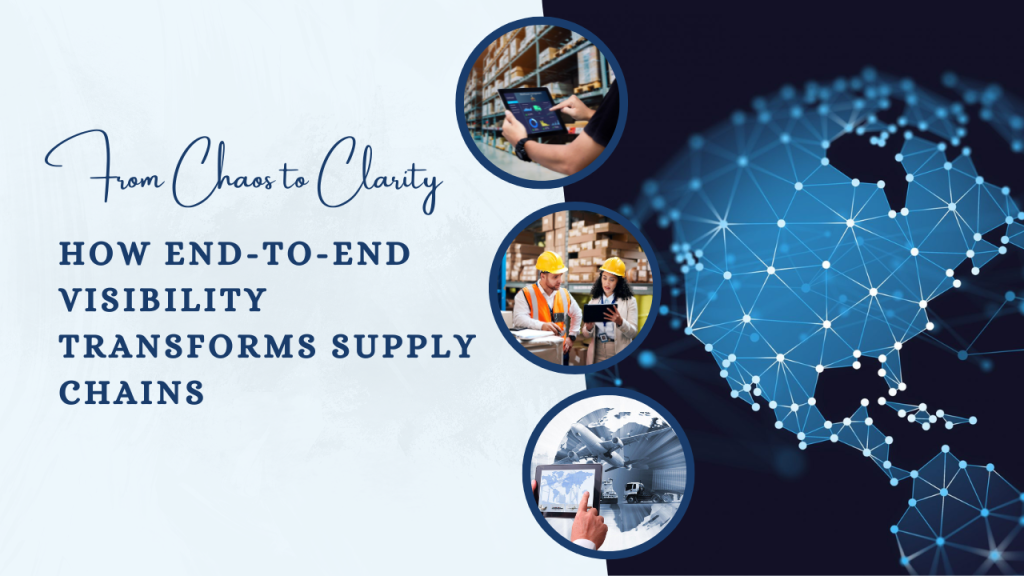From Chaos to Clarity: How End-to-End Visibility Transforms Supply Chains

Introduction
In today’s fast-paced and interconnected business landscape, supply chains have become a vital component of success for organizations across various industries.
Ensuring smooth and seamless operations within supply chains is no easy task, as numerous challenges and obstacles can impede efficiency and profitability. However, with the advent of end-to-end visibility in Control Tower Management, the supply chain has taken a significant leap forward, transforming chaos into clarity.
This blog will explore the concept of end-to-end visibility in Control Tower Management, its benefits, challenges, and best practices for successful implementation.
Get ready to dive into this comprehensive blog with me.
The Challenges of Traditional Supply Chains
Before going to see End-to-end visibility, Let’s take a quick glimpse about what are the major challenges traditional supply chains face.
Traditional supply chains often lack real-time data and information, hindering decision-making and response times.
In addition, communication and coordination inefficiencies plague supply chains, leading to delays and disruptions. Furthermore, traditional supply chains are highly vulnerable to risks and disruptions, whether due to natural disasters, supplier issues, or market fluctuations.
So, to avoid these hindrances, Modern supply chain control towers provide end-to-end visibility.
What exactly is end-to-end visibility in a modern supply chain?
At its core, end-to-end visibility refers to the ability to track and monitor every aspect of the supply chain, from the procurement of raw materials to the delivery of the final product to customers.
This comprehensive visibility allows organizations to gain insights into the entire supply chain ecosystem, enabling improved decision-making, heightened operational efficiency, and enhanced risk management.
Why Is Supply Chain Visibility Important?
As companies outsource more and more of their supply chains, it can become difficult to manage. Supply chain visibility provides transparency that can improve your interactions with suppliers and customers.
With complete visibility, you can track the movement of goods throughout the supply chain. This includes documentation of raw materials, components used in production, and the exact location of finished goods. You can also track goods as they travel from the plant to customers by ship, truck, or plane, through customs and other checkpoints.
A corporate responsibility solution should be included in your digital supply chain platform to track social compliance and environmental status. This allows you to initiate, review, monitor, and submit corrective action plans.

So, in simple terms, Supply chain visibility is like having a bird’s-eye view of your entire supply chain. It helps you to see where your products are at all times, and to identify any potential problems early on. This can help you to improve your relationships with suppliers and customers and to ensure that your products are produced and delivered in a sustainable way. So, this is where supply chain visibility comes in.
Key components and technologies involved
Achieving end-to-end visibility requires data integration and connectivity across all levels of the supply chain, ensuring a seamless flow of information and real-time updates.
End-to-end supply chain typically includes advanced analytics and artificial intelligence (AI) to analyze vast amounts of data, Internet of Things (IoT) and sensor technologies to gather real-time information, and collaborative data sharing to enable smooth communication and integration across the supply chain network.
How to achieve end-to-end visibility?
There are a number of ways to achieve end-to-end visibility in Modern supply chains.
One approach is to use a supply chain management (SCM) platform. SCM platforms provide a centralized view of the supply chain, which can be used to track inventory levels, shipments, and other key data from all parties involved.
Another approach to achieving end-to-end visibility is to use a combination of different technologies, such as RFID tags (Radio-frequency identification), sensors, and blockchain.
- RFID tags can be used to trace the movement of goods throughout the supply chain.
- Sensors can be used to collect data on temperature, humidity, and other environmental parameters.
- Blockchain can be used to produce a tamper-proof record of all transactions in the supply chain.
Benefits of End-to-End Visibility
End-to-end visibility in the supply chain can help you to make better decisions, streamline your operations, reduce risks, and be more compliant.
Here are some specific examples of how end-to-end visibility can benefit businesses:
- A retailer can use end-to-end visibility to identify potential stockouts and ensure that customers always have the products they need.
- A manufacturer can use end-to-end visibility to optimize its production schedule and reduce waste.
- A logistics company can use end-to-end visibility to track shipments and ensure that they arrive on time and in good condition.
Conclusion
End-to-end visibility is a powerful tool that can help businesses to transform their supply chains. End-to-end visibility can help businesses improve customer service, reduce costs, increase efficiency, and make better decisions by providing a holistic view of the supply chain. As the supply chain landscape continues to evolve, it is imperative for organizations to seize the opportunities presented by end-to-end visibility and pave the way for a more resilient and efficient future.
Mail me, if in case any queries strike it out, and I will be happy to reply to you!!!
